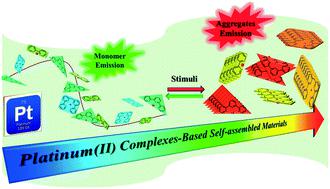当前位置:
X-MOL 学术
›
Mol. Syst. Des. Eng.
›
论文详情
Our official English website, www.x-mol.net, welcomes your
feedback! (Note: you will need to create a separate account there.)
Visual self-assembly and stimuli-responsive materials based on recent phosphorescent platinum(II) complexes
Molecular Systems Design & Engineering ( IF 3.2 ) Pub Date : 2020-10-05 , DOI: 10.1039/d0me00113a Baoning Li 1, 2, 3, 4, 5 , Zhenjie Liang 1, 2, 3, 4, 5 , Huijie Yan 1, 2, 3, 4, 5 , Yongguang Li 1, 5, 6, 7, 8
Molecular Systems Design & Engineering ( IF 3.2 ) Pub Date : 2020-10-05 , DOI: 10.1039/d0me00113a Baoning Li 1, 2, 3, 4, 5 , Zhenjie Liang 1, 2, 3, 4, 5 , Huijie Yan 1, 2, 3, 4, 5 , Yongguang Li 1, 5, 6, 7, 8
Affiliation

|
Platinum(II) complexes with various π-conjugated ligands have received great attention thanks to their exceptional spectroscopic properties and applications in optical devices, chemical sensors, and bio-imaging. Their unique square-planar structures and coordinate-unsaturation characteristics induce the propensity to form self-assembled phosphorescent materials through metal–metal, π–π stacking, and other intermolecular interactions. In this review, we mainly describe the photophysical properties and structure–property relationships of multi-chelating platinum(II) complexes as well as the construction and application of phosphorescent supramolecular materials in recent years.
中文翻译:

基于最近的磷光铂(II)配合物的视觉自组装和刺激响应材料
具有各种π共轭配体的铂(II)配合物由于其出色的光谱性质以及在光学设备,化学传感器和生物成像中的应用而受到了广泛的关注。它们独特的正方形平面结构和坐标不饱和特性引起了通过金属-金属,π-π堆积和其他分子间相互作用形成自组装磷光材料的倾向。在这篇综述中,我们主要描述了多螯合铂(II)配合物的光物理性质和结构-性质关系,以及近年来磷光超分子材料的构建和应用。
更新日期:2020-11-03
中文翻译:

基于最近的磷光铂(II)配合物的视觉自组装和刺激响应材料
具有各种π共轭配体的铂(II)配合物由于其出色的光谱性质以及在光学设备,化学传感器和生物成像中的应用而受到了广泛的关注。它们独特的正方形平面结构和坐标不饱和特性引起了通过金属-金属,π-π堆积和其他分子间相互作用形成自组装磷光材料的倾向。在这篇综述中,我们主要描述了多螯合铂(II)配合物的光物理性质和结构-性质关系,以及近年来磷光超分子材料的构建和应用。











































 京公网安备 11010802027423号
京公网安备 11010802027423号